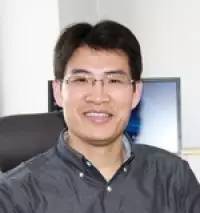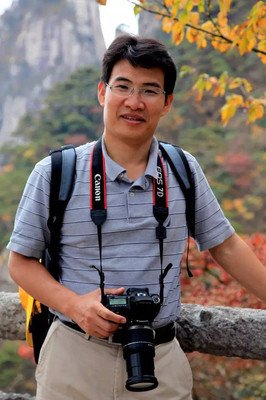高紹榮
| 高紹榮 |
 |
高紹榮,是中國科學院動物研究博士,教授、博士生導師[1],同濟大學生命科學與技術學院院長[2],轉化醫學高等研究院副院長。國家傑出青年科學基金獲得者[3]。
2021年11月3日,高紹榮主持的項目"早期胚胎髮育與體細胞重編程的表觀調控機制研究"獲2020年度國家自然科學獎二等獎[4]。
基本信息
人物說明----同濟大學生命科學與技術學院院長
國 籍 ---- 中國
職 業 ---- 教育科研工作者
畢業院校----中國科學院動物研究所
學位/學歷----博士
專業方向----幹細胞與體細胞重編程
職 稱 ---- 教授
人物經歷
1993年於山東農業大學獲學士學位,1996年於中國農業大學獲得碩士學位,2000年於中國科學院動物研究所獲博士學位,先後在美國布朗大學、英國羅斯林研究所和美國坦普爾大學進行聯合培養和博士後研究,2004至2005年在美國康涅狄格州大學任研究助理教授,2005至2013年在北京生命科學研究所任研究員、高級研究員,2013年8月起任同濟大學特聘教授。
1998年至2000年,在美國布朗大學醫學院任研究助理。 2000年至2002年,在英國羅斯林研究所進行博士後研究,師從"克隆羊之父"伊恩威爾穆特教授。 2002年至2004年,在美國坦普爾大學醫學院進行博士後研究。 2004年至2005年,在美國康涅狄格州大學任研究助理教授。 2005年至2013年,在北京生命科學 研究所任研究員、高級研究員。 2013年起任同濟大學生命科學與技術學院特聘教授,院長。
學術任職
中國動物學會細胞及分子顯微技術學會副理事長、中國細胞生物學會幹細胞生物學分學會理事、中國細胞生物學會再生細胞生物學分會理事、中國動物學會生殖生物學分會理事、中國遺傳學會發育遺傳專業委員會委員、中國幹細胞工程技術學會理事。是J. Biol. Chem., J. Reprod. Dev., Cellular Reprogramming, Cell Regeneration 等四個國際期刊的編委和Journal of Animal Science and Biotechnology副主編。
課題主持
1. 科技部"幹細胞與轉化研究" 國家重點研發計劃,2016YFA0100400,組蛋白及DNA修飾在細胞編程與重編程過程中的相互關聯與動態調控機制研究,2016/08-2020/12, 3000萬元,在研,首席科學家
2. 國家自然科學基金重點項目,81630035,人卵母細胞和早期胚胎髮育異常的分子機制及干預研究,2017/01-2021/12, 278萬元,在研,主持
3. 國家自然科學基金重點項目,31430056,早期胚胎端粒延長的分子機制及其在體細胞重編程中的功能研究, 2015/01-2019/12,353 萬元,在研,主持。
4. 國家傑出青年基金,31325019,體細胞重編程,2014/01-2017/12,320萬元,在研,主持。
5. 國家自然科學基金委重大研究計劃集成項目,91319306、利用連續重編程體系研究體細胞重編程的表觀遺傳機制,2014/01-2016/12,300 萬元,在研,主持。
研究領域
高紹榮教授課題組主要從事早期胚胎髮育、體細胞重編程與幹細胞的分子機制與轉化研究。主要研究方向包括:
1.早期胚胎髮育尤其是細胞全能性建立與第一次細胞命運決定的表觀遺傳調控機制;
2.利用體細胞核移植與誘導多能幹細胞技術研究體細胞重編程的分子機制;
3. 利用病人誘導多能幹細胞進行疾病發生機制及幹細胞轉化醫學研究。
| 高紹榮 |
 |
研究成果及獲獎
研究成果
高紹榮教授主要利用體細胞核移植與誘導多能幹細胞(即iPS細胞)技術從事體細胞重編程分子機制與轉化研究,取得了一系列重要進展,主要研究成果包括:
1. 在iPS細胞多能性研究中取得突破性研究成果,其領導的研究團隊是世界上首次證明了iPS細胞真正多能性的兩個實驗室之一。該研究成果引起世界廣泛關注,被美國時代雜誌評為2009年世界十大醫學突破之一,高紹榮教授於2011年獲得周光召基金會"傑出青年基礎科學獎", 該研究成果也為我國幹細胞研究在國際上贏得了話語權,相關論文已被引用400餘次。
2. 首次從全基因組水平上揭示了小鼠植入前胚胎髮育過程中的組蛋白H3K4me3和HK27me3修飾建立過程,並發現寬的(broad)H3K4me3修飾在植入前胚胎髮育過程中對基因表達起了很重要的調控作用。文章發表在國際頂級學術期刊Nature,同期Nature並配發評論介紹該項工作的重要性。
3. 發現核移植幹細胞較iPS細胞具有延長端粒,改善端粒功能以及具有更好的線粒體功能,為進一步提高iPS細胞質量提供了依據,先關研究成果發表在Cell Stem Cell上;證明DNA羥甲基化酶Tet1可以促進體細胞重編程,提高iPS細胞誘導效率;首次建立TSKM二次誘導體系,基於此系統初步解析了在體細胞中過表達Tet1誘導體細胞重編程的分子機制,該研究成果以封面形式發表於2013年4月Cell Stem Cell上,並被評為2013年最佳論文之一,論文發表以來已經被引用超過150次。這兩項研究都為進一步提高iPS細胞質量提供了重要的理論依據。
4. 其研究團隊在國際上首次對轉錄因子誘導獲得的純合子地中海貧血病人iPS細胞進行了突變基因修復,並證明修復後的iPS細胞可以在體外分化為造血前體細胞,進一步證明移植的細胞可以在小鼠體內分化為產生人珠蛋白的血細胞,為iPS細胞的臨床轉化應用提供了理論依據。
獲獎
2005年以來,曾主持和參加多項國家基金委、科技部和上海市等科研項目。在Nature, Science, Cell Stem Cell等國際著名學術期刊發表論文100餘篇。2013年獲得國家傑出青年科學基金資助;2014年入選科技部中青年科技創新領軍人才;2015年入選國家百千萬人才工程,並被授予"有突出貢獻中青年專家"榮譽稱號;2016年入選第二批"萬人計劃"領軍人才,獲政府特殊津貼。2009年獲得藥明康德生命化學研究獎;2011年獲得周光召基金會傑出青年基礎科學獎;2014年獲國家自然科學二等獎;2015年獲得談家楨生命科學創新獎。
2021年11月3日,高紹榮主持的項目"早期胚胎髮育與體細胞重編程的表觀調控機制研究"獲2020年度國家自然科學獎二等獎,獲獎人員包括:高紹榮、高亞威、張勇、陳嘉瑜、鞠振宇 。
2022年6月28日,入選2022年度生命科學部國家傑出青年科學基金項目和國家自然科學基金創新研究群體項目專家評審組名單。
代表性論文
1. Liu X, Wang C, Liu W, Li J, Li C, Kou X, Chen J, Zhao Y, Gao H, Wang H, Zhang Y, Gao Y, Gao S. (2016) Distinct features of H3K4me3 and H3K27me3 chromatin domains in pre-implantation embryos. Nature 537(7621):558-562. (Previewed by Nature)
2. Kang L, Wang J, Zhang Y, Kou Z, Gao S. (2009) iPS cells can support full term development of tetraploid blastocyst-complemented embryos. Cell Stem Cell 5(2):135-138. (Highlighted by Nature, Nature China; Selected as "Must Read" by Faculty 1000; Featured in TIME Magazine, Washington Post, Wall Street Journal, Xinhua News, USA Today, The Scientist, The Economist, ABC News, The Independent, Scientific America etc.)
3. Yuan W, Wu T, Fu H, Dai C, Wu H, Liu N, Li X, Xu M, Zhang Z, Niu T, Han Z, Chai J, Zhou XJ, Gao S, Zhu B. (2012) Dense chromatin activates Polycomb repressive complex 2 to regulate H3 lysine 27 methylation. Science 337(6097):971-5. (Co-correspondence, Previewed by Science)
4. Gao Y, Chen J, Li K, Wu T, Huang B, Liu W, Kou X, Zhan Y, Huang H, Jiang Y, Yao C, Liu X, Lu Z, Xu Z, Kang L, Chen J, Wang H, Cai T, Gao S. (2013) Replacement of Oct4 by Tet1 during iPSC induction reveals an important role of DNA methylation and hydroxymethylation in reprogramming. Cell Stem Cell 12(4):453-69. (Cover Story; Previewed by Cell Stem Cell; Selected as Best of 2013 by Cell Stem Cell)
5. Le R, Kou Z, Jiang Y, Li M, Huang B, Liu W, Li H, Kou X, He W, Rudolph KL, Ju Z, Gao S. (2014) Enhanced telomere rejuvenation in pluripotent cells reprogrammed via nuclear transfer relative to induced pluripotent stem cells. Cell Stem Cell 14(1):27-39.
6. Chen J, Chen X, Li M, Liu X, Gao Y, Kou X, Zhao Y, Zheng W, Zhang X, Huo Y, Chen C, Wu Y, Wang H, Jiang C, Gao S. (2016) Hierarchical Oct4 Binding in Concert with Primed Epigenetic Rearrangements during Somatic Cell Reprogramming. Cell Reports 14(6):1540-54.
7. Wang Y, Wu Q, Yang P, Wang C, Liu J, Ding W, Liu W, Bai Y, Yang Y, Wang H, Gao S, Wang X. (2016) LSD1 co-repressor Rcor2 orchestrates neurogenesis in the developing mouse brain. Nat Commun. 7:10481. (Co-correspondence)
8. Gao S, Zheng C, Chang G, Liu W, Kou X, Tan K, Tao L, Xu K, Wang H, Cai J, Tian J, Gao S. (2015) Unique features of mutations revealed by sequentially reprogrammed induced pluripotent stem cells. Nat Commun. 6:6318.
9. Wang S, Kou Z, Jing Z, Zhang Y, Guo X, Dong M., Wilmut I, Gao S. (2010) Proteome of mouse oocytes at different developmental stages. Proc. Natl. Acad. Sci. USA 107(41):17639-44.
10. Liu W, Yin J, Kou X, Jiang Y, Gao H, Zhao Y, Huang B, He W, Wang H, Han Z, Gao S. (2014) Asymmetric reprogramming capacity of parental pronuclei in mouse zygotes. Cell Reports 6(6):1008-1016.
11. Yang Y, Zhang X, Yi L, Hou Z, Chen J, Kou X, Zhao Y, Wang H, Sun XF, Jiang C, Wang Y, Gao S. (2016) Naïve Induced Pluripotent Stem Cells Generated From β-Thalassemia Fibroblasts Allow Efficient Gene Correction With CRISPR/Cas9. Stem Cells Transl Med. 5(1):8-19.
12. Kou Z, Wu Q, Kou X, Yin C, Wang H, Zuo Z, Zhuo Y, Chen A, Gao S, Wang X. (2015) CRISPR/Cas9-mediated genome engineering of the ferret. Cell Res. 25(12):1372-5. (Co-correspondence)
| 高紹榮 |
 |
13. Xu Q, Wang F, Xiang Y, Zhang X, Zhao ZA, Gao Z, Liu W, Lu X, Liu Y, Yu XJ, Wang H, Huang J, Yi Z, Gao S, Li L. (2015) Maternal BCAS2 protects genomic integrity in mouse early embryonic development. Development. 142(22):3943-53. (Co-correspondence)
14. Zhu X, Wang F, Zhao Y, Yang P, Chen J, Sun H, Liu L, Li W, Pan L, Guo Y, Kou Z, Zhang Y, Zhou C, He J, Zhang X, Li J, Han W, Li J, Liu G, Gao S, Yang Z. (2014) A Gain-of-Function Mutation in Tnni2 Impeded Bone Development through Increasing Hif3a Expression in DA2B Mice. PLoS Genet. 2014 Oct 23;10(10):e1004589. (Co-correspondence)
15. Chen J, Gao Y, Huang H, Jiang Y, Li H, Gao S, Tao Y, Wang H, Wang H, Cai T, Gao S. (2015) The combination of Tet1 with Oct4 generates high-quality mouse induced pluripotent stem cells (iPSCs). Stem Cells. 33(3):686-98.
16. Chen Q, Gao S, He W, Kou X, Zhao Y, Wang H, Gao S. (2014) Xist repression shows time-dependent effects on the reprogramming of female somatic cells to iPSCs. Stem Cells. 32(10):2642-2656.
17. Chang G, Gao S, Hou X, Xu Z, Liu Y, Kang L, Tao Y, Liu W, Huang B, Kou X, Chen J, An L, Miao K, Di K, Wang Z, Tan K, Cheng T, Cai T, Gao S, Tian J. (2014) High-throughput sequencing reveals the disruption of methylation of imprinted gene in induced pluripotent stem cells. Cell Research 24(3):293-306. (Co-correspondence)
18. Liu Y, Cheng H, Gao S, Lu X, He F, Hu L, Hou D, Zou Z, Li Y, Zhang H, Xu J, Kang L, Wang Q, Yuan W, Gao S, Cheng T. (2013) Reprogramming of MLL-AF9 leukemia cells into pluripotent stem cells. Leukemia. 28(5):1071-80. (Co-correspondence)
19. Jiao J, Yang Y, Shi Y, Chen J, Gao R, Fan Y, Yao H, Liao W, Sun XF, Gao S. (2013) Modeling Dravet syndrome using induced pluripotent stem cells (iPSCs) and directly converted neurons. Hum Mol Genet. 22(21):4241-52.
20. Jiao J, Dang Y, Yang Y, Gao R, Zhang Y, Kou Z, Sun XF, Gao S. (2013) Promoting reprogramming by FGF2 reveals that the extracellular matrix is a barrier for reprogramming fibroblasts to pluripotency. Stem Cells 31(4):729-40.
21. Wang Y, Zheng C, Jiang Y, Zhang J, Chen J, Yao C, Zhao Q, Liu S, Chen K, Du J, Yang Z, Gao S. (2012) Genetic correction of β-thalassemia patient-specific iPS cells and its use in improving hemoglobin production in irradiated SCID mice. Cell Research 22(4):637-48.
22. Yang P, Wang Y, Chen J, Li H, Kang L, Zhang Y, Chen S, Zhu B, Gao S. (2011) RCOR2 is a subunit of the LSD1 complex that regulates ES cell property and substitutes for SOX2 in reprogramming somatic cells into pluripotency. Stem Cells 29(5):791-801.
23. Wu T, Wang H, He J, Kang L, Jiang Y, Liu J, Zhang Y, Kou Z, Liu L, Zhang X, Gao S. (2011) Reprogramming of trophoblast stem cells into pluripotent stem cells by Oct4. Stem Cells 29(5):755-63.
24. Kang L, Wu T, Tao Y, Yuan Y, He J, Zhang Y, Luo T, Kou Z, Gao S. (2011) Viable mice produced from 3-factor induced pluripotent stem (iPS) cells through tetraploid complementation. Cell Research 21(3):546-9.
25. Hu J, Wang F, Yuan Y, Zhu X, Wang Y, Zhang Y, Kou Z, Wang S, Gao S. (2010) The novel importin-alpha family member Kpna7, is required for normal fertility and fecundity in the mouse. J. Biol. Chem. 285(43):33113-22.
26. Kou Z, Kang L, Yuan Y, Tao Y, Zhang Y, Wu T, He J, Wang J, Liu Z, Gao S. (2010) Mice cloned from induced pluripotent stem cells (iPSCs). Biol. Reprod. 83:238-243.
27. Zhao Q, Wang J, Zhang Y, Kou Z, Liu S and Gao S. (2010) Generation of histocompatible androgenetic embryonic stem cells using spermatogenic cells. Stem Cells 2010; 28(2):229-239.
28. Zhang M, Wang F, Kou Z, Zhang Y, Gao S. (2009) Defective chromatin structure in somatic cell cloned embryos. J. Biol. Chem. 284(37):24981-7. 29. Guo X, Gao S. (2009) LGN regulates meiotic spindle organization, anchoring and involves in cortical polarization during mouse oocytes maturation. Cell Research 19(7):838-48.
30. Wang Y, Jiang Y, Liu S, Sun X, Gao S. (2009) Generation of induced pluripotent stem cells from human beta-thalassemia fibroblast cells. Cell Research 19(9):1120-3.
31. Sung LY*, Gao S*, Shen H, Yu H, Song Y, Smith SL, Chang CC, Kuo L, Lian J, Tian XC, Tuck DP, Weissman SM, Yang X, Cheng T (2006) Differentiated cells are more efficient than adult stem cells for cloning by somatic cell nuclear transfer. Nat. Genet. 38(11): 1323-1328. (* Co-first author)
參考來源
- 移至 ↑ 遼大生命·名師講壇(四)通知 ,遼寧大學, 2022-12-01
- 移至 ↑ 胡興禹會見同濟大學生命學院院長高紹榮教授 ,山東理工大學, 2023-01-27
- 移至 ↑ 高紹榮:同濟大學生命科學與技術學院院長、教授 ,世紀名人網, 2021-06-27
- 移至 ↑ 同濟大學高紹榮教授牽頭項目獲國家自然科學獎二等獎!研究核心關注生命最初的胚胎髮育階段 ,文匯報, 2021-11-03